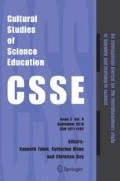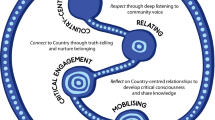Abstract
This article is a response to Kassam, Avery, and Ruelle’s insights as presented in this forum on rural science education. Topics considered include troubling the urban/rural divide in the context of Indigenous knowledge and expanding to include the common Canadian notion of the “remote”, a designation rooted in our national colonial narrative for the mythic, typically northern, wilderness sparsely inhabited by primarily Indigenous peoples. These concepts are further considered through exploration of Indigenous and allied ecological activism in Canada and the United States related to the proposed Northern Gateway and Keystone XL pipelines. This discussion concludes with an argument for the inherent pedagogical opportunity presented by such cases for contemporary educators to engage students in consideration of wicked problems, geographically rooted cognitive diversity, and the legal, economic, ecological, and cultural underpinnings and ramifications of the current events prominent in their home communities and abroad.
Similar content being viewed by others
References
Agyeman, J., Cole, P., Haluza-DeLay, R., & O’Riley, P. (Eds.). (2009). Speaking for ourselves: Environmental justice in Canada. Vancouver: University of British Columbia Press.
Awasis, S. (2014). Pipelines and resistance across Turtle Island. In T. Weis, T. Black, S. D’Arcy, & J. Kahn Russell (Eds.), A line in the Tar Sands (pp. 253–266). Toronto: Between the Lines.
Brown, J. S. (1983). Women as centre and symbol of the emergence of Metis communities. Canadian Journal of Native Studies, 3, 39–46.
Carrington, K., McIntosh, A., & Scott, J. (2010). Globalization, frontier masculinities and violence: Booze, blokes and brawls. British Journal of Criminology, 50, 393–413. doi:10.1093/bjc/azq003
Climate Action Network. (2013). Canada wins ‘Lifetime Unachievement’ fossil award at Warsaw climate talks. Retrieved September 18, 2014, from http://climateactionnetwork.ca/2013/11/22/canada-wins-lifetime-unachievement-fossil-award-at-warsaw-climate-talks/#sthash.3sZlcshi.dpuf
Collective, Kino-nda-niimi (Ed.). (2014). The winter we danced: Voices from the past, the future, and the Idle No More movement. Winnipeg: Arbeiter Ring Publishing.
Davenport, C. (2015). Senate fails to override Obama’s Keystone pipeline veto. The New York Times Online. Retrieved April 14, 2015, from http://www.nytimes.com/2015/03/05/us/senate-fails-to-override-obamas-keystone-pipeline-veto.html?_r=0
Donald, D. (2004). Edmonton pentimento: Re-reading history in the case of the Papaschase Cree. Journal of the Canadian Association for Curriculum Studies, 2, 21–54.
Enbridge Northern Gateway Joint Review Panel. (2014). Decision statement issued under Section 54 of the Canadian Environmental Assessment Act, 2012 and Paragraph 104 (4) (b) of the Jobs, Growth and Long-term Prosperity Act. Ottawa: Government of Canada. Retrieved April 14, 2015, from http://gatewaypanel.review-examen.gc.ca/clf-nsi/dcmnt/dcsnsttmnt-eng.html
Foster, J. E. (2007). Wintering, the outsider male and the ethnogenesis of the western plains Métis. In P. C. Douad (Ed.), The Western Métis: Profile of a people (pp. 91–103). Regina: Canadian Plains Research Centre. (Original work published 1994).
Francis, D. (2005). National dreams: Myth, memory, and Canadian history. Vancouver: Arsenal Pulp Press.
Gibbins, R. (2005). Meaning and significance of the Canadian-American border. In P. Ganster & D. E. Lorey (Eds.), Borders and border politics in a globalizing world (pp. 151–168). Oxford: SR Books.
Gorlewski, J., & Porfilio, B. (2012). Revolutionizing environmental education through Indigenous hip hop culture. Canadian Journal of Environmental Education, 17, 46–61.
Gunton, T., & Broadbent, S. (2013). A spill risk assessment of the Enbridge Northern Gateway project. Burnaby: School of Resource and Environmental Management, Simon Fraser University.
Hall, B. L., Clover, D., Crowther, J., & Scandrett, E. (2013). Learning and education for a better world: The role of social movements. New York: Springer.
Harding, D. (2013). Environmental rhetoric: A framing analysis of stakeholder claims surrounding the Northern Gateway pipeline. Unpublished master’s thesis, Concordia University, Montreal.
Jickling, B. (2003). Environmental education and advocacy: Revisited. The Journal of Environmental Education, 34, 20–27. doi:10.1080/00958960309603496
Kassam, K. A. S., Avery, L. M., & Ruelle, M. L. (2016). The cognitive relevance of indigenous and rural: Why is it critical to survival? Cultural Studies of Science Education. doi:10.1007/s11422-016-9745-5.
Kimmerer, R. W. (2013). The fortress, the river and the garden: A new metaphor for cultivating mutualistic relationship between scientific and traditional ecological knowledge. In A. Kulnieks, D. R. Longboat, & K. Young (Eds.), Contemporary studies in environmental and Indigenous pedagogies (pp. 49–76). Rotterdam: Sense. doi:10.1007/978-94-6209-293-8_4
LaDuke, W. (2014). Ending the age of fossil fuels and building an economics for the Seventh Generation. In T. Black, S. D’Arcy, T. Weis, & J. Kahn Russell (Eds.), A line in the Tar Sands (pp. 229–239). Toronto: Between the Lines.
Lowan-Trudeau, G. (2015a). Pipe dreams: A tale of two cities. In M. Robertson, R. Lawrence, & G. Heath (Eds.), Experiencing the outdoors: Enhancing strategies for wellbeing (pp. 37–48). Rotterdam: Sense Publishers.
Lowan-Trudeau, G. (2015b). Teaching the tension: Indigenous land rights, activism, and education in Canada. Education Canada, 55, 44–47.
Malenfant, E. C., Lebel, A., & Martel, L. (2010). Projections of the diversity of the Canadian population. Ottawa: Statistics Canada.
Menzies, C. R. (Ed.). (2006). Traditional ecological knowledge and natural resource management. Lincoln: University of Nebraska Press.
Neil, G. (2014). An inquiry into the Northern Gateway pipeline. Calgary: Connect Charter School. Retrieved December 1, 2015, from https://connectcharterschoolblog.wordpress.com/2014/09/25/an-inquiry-into-the-northern-gateway-pipeline/
Ozog, S. (2012). Towards First Nations energy self-sufficiency: Analyzing the renewable energy partnership between Tsou-ke Nation and Skidegate Band. Unpublished master’s thesis, University of Northern British Columbia, Prince George.
Prystupa, M. (2014). Janet Holder quits Northern Gateway pipeline. Vancouver Observer Online. Retrieved April 14, 2015, from http://www.vancouverobserver.com/news/janet-holder-quits-northern-gateway-project
Raffan, J. (2008). Emperor of the North: Sir George Simpson and the remarkable story of the Hudson’s Bay Company. Toronto: Harper Collins Publishers Ltd.
Reject and Protect. (2014). Reject and protect. Retrieved April 14, 2015, from http://rejectandprotect.org
Rivard, E. (2008). Colonial cartography of Canadian margins: Encounters and the idea of métissage. Cartographica, 43, 45–66. doi:10.3138/carto.43.1.45
Theobald, P., & Herley, W. (2009). Rurality, locality, and the diversity question. In S. R. Steinberg (Ed.), Diversity and multiculturalism: A reader (pp. 423–434). New York: Peter Lang.
Trans Canada (2015). Keystone XL pipeline. Retrieved April 1, 2015, from http://keystone-xl.com/?gclid=COf63rv69MQCFUuTfgode1YA2Q
Vink, M. J., Dewulf, A., & Termeer, C. J. A. (2013). The role of knowledge and power in climate change adaptation governance: A systematic literature review. Ecology and Society, 18(4), 46. doi:10.5751/ES-05897-180446
Weber, B. A., Geigle, J., & Barkdull, C. (2014). Rural North Dakota’s oil boom and its impact on social services. Journal of Social Work, 59(1), 62–72. doi:10.1093/sw/swt068
Wheatley, B., & Paradis, S. (1995). Exposure of Canadian aboriginal peoples to methylmercury. Water, Air, and Soil Pollution, 80(1–4), 3–11. doi:10.1007/978-94-011-0153-0_1
Author information
Authors and Affiliations
Corresponding author
Additional information
Lead Editors: L. Avery and D. Long.
This paper is part of the special issue Cultural Studies of Rural Science Education.
This review essay addresses issues raised in Karim-Aly Kassam, Leanne Avery and Morgan Ruelle’s paper entitled: The cognitive relevance of rural: Why is it critical to survival? doi:10.1007/s11422-016-9745-5.
Rights and permissions
About this article
Cite this article
Lowan-Trudeau, G. Gateway to understanding: Indigenous ecological activism and education in urban, rural, and remote contexts. Cult Stud of Sci Educ 12, 119–128 (2017). https://doi.org/10.1007/s11422-016-9746-4
Received:
Accepted:
Published:
Issue Date:
DOI: https://doi.org/10.1007/s11422-016-9746-4




